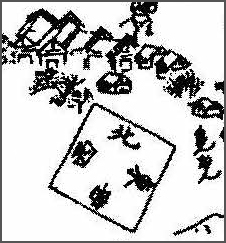https://wkdfestivalsaijiki.blogspot.jp/2010/09/ise-shrine-and-its-kigo.html
:::::::::::::::::::::::::::::::::::::::::::::::::::::::::::::::::::::::::::::::::::::::::::::::::::::
Ise Ondo 伊勢温度 Ise Song and Dance

Ryuryukyo Shinsai (1764 – 1820)
This is one of the most famous folk songs and dances. It spread over most of Japan because the Ise Pilgrims have been singing it.
- quote -
Ise Ondo Koi no Netaba 伊勢音頭恋寝刃
The Ise Dances and Love's Dull Blade
The drama "Ise Ondo Koi no Netaba" was premiered in the 7th lunar month of 1796 in Ôsaka, produced at the Kado no Shibai by the zamoto Fujikawa Hachizô III].
The play is loosely based on a real killing spree which took place in Furuichi (aburaya Sôdô), and which caused a sensation, about two months before the play's premiere in the 7th lunar month of 1796. The murders that inspired it having taken place in summer, "Ise Ondo" is a "summer play", with characters wearing light cotton yukata and using fans, and the Aburaya House of Pleasure's curtains being decorated with patterns of flowing water and floating bowls.
- Full text of all scenes :
Scenes no longer normally staged
Penultimate scene of Act I: by a jizô statue in a field
Last scene of Act I: Futami-ga-Ura
Final scene of Act II (which is not normally performed): within the precincts of the Ise Shrine
Act III, Scene 1: a room in the Aburaya House of Pleasure in Furuichi
Act III, Scene 2: in inner courtyard at the Aburaya
Act IV - versions
- source : kabuki21.com -

CLICK for more kabuki photos !
. Japanese Legends - 伝説 民話 昔話 – ABC-List .
A legend from Nara, 橿原市 Kashihara town
A man named 惣五郎 Sogoro once finished planting a large rice field, when he found a young fox dead by the field side. So he burried the poor animal and said prayers for its soul.
At night he heard voices of five or six people at the door, calling out:
"Hey you rice-planter Sogoro, we pulled them all out!"
It must have been the parents of the young fox, who by mistake thought he had killed their child.
Sogoro took pity on them too, sat by the field and explained the events again and again.
That night he heard the voices again, singing the Ise Ondo and then telling him:
"Sorry we pulled your plants out! But now, they are all replanted!"
Next morning he found some 鏡餅 offerings in front of his door and all the fields were planted as before.
- reference : Nichibun Yokai Database -
:::::::::::::::::::::::::::::::::::::::::::::::::::::::::::::::::::::::::::::::::::::::::::::::::::::
:::::::::::::::::::::::::::::::::::::::::::::::::::::::::::::::::::::::::::::::::::::::::::::::::::::
Ise Ondo 伊勢温度 Ise Song and Dance

Ryuryukyo Shinsai (1764 – 1820)
This is one of the most famous folk songs and dances. It spread over most of Japan because the Ise Pilgrims have been singing it.
- quote -
Ise Ondo Koi no Netaba 伊勢音頭恋寝刃
The Ise Dances and Love's Dull Blade
The drama "Ise Ondo Koi no Netaba" was premiered in the 7th lunar month of 1796 in Ôsaka, produced at the Kado no Shibai by the zamoto Fujikawa Hachizô III].
The play is loosely based on a real killing spree which took place in Furuichi (aburaya Sôdô), and which caused a sensation, about two months before the play's premiere in the 7th lunar month of 1796. The murders that inspired it having taken place in summer, "Ise Ondo" is a "summer play", with characters wearing light cotton yukata and using fans, and the Aburaya House of Pleasure's curtains being decorated with patterns of flowing water and floating bowls.
- Full text of all scenes :
Scenes no longer normally staged
Penultimate scene of Act I: by a jizô statue in a field
Last scene of Act I: Futami-ga-Ura
Final scene of Act II (which is not normally performed): within the precincts of the Ise Shrine
Act III, Scene 1: a room in the Aburaya House of Pleasure in Furuichi
Act III, Scene 2: in inner courtyard at the Aburaya
Act IV - versions
- source : kabuki21.com -

CLICK for more kabuki photos !
. Japanese Legends - 伝説 民話 昔話 – ABC-List .
A legend from Nara, 橿原市 Kashihara town
A man named 惣五郎 Sogoro once finished planting a large rice field, when he found a young fox dead by the field side. So he burried the poor animal and said prayers for its soul.
At night he heard voices of five or six people at the door, calling out:
"Hey you rice-planter Sogoro, we pulled them all out!"
It must have been the parents of the young fox, who by mistake thought he had killed their child.
Sogoro took pity on them too, sat by the field and explained the events again and again.
That night he heard the voices again, singing the Ise Ondo and then telling him:
"Sorry we pulled your plants out! But now, they are all replanted!"
Next morning he found some 鏡餅 offerings in front of his door and all the fields were planted as before.
- reference : Nichibun Yokai Database -
:::::::::::::::::::::::::::::::::::::::::::::::::::::::::::::::::::::::::::::::::::::::::::::::::::::






































